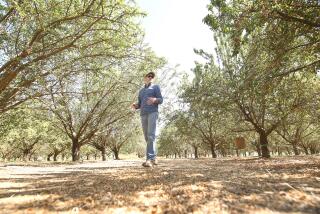Bugged by Malathion : Residents, Activists Plot to Halt Impending Air Assault on Medfly
With just a few days to go, a handful of Camarillo residents plotted with anti-malathion activists Sunday to stop the coming rain of pesticide.
They tossed around ideas--phone trees, lapel buttons, petitions, speeches, pressure.
And they vowed to do everything possible to disrupt the six-month, biweekly aerial-spraying plan, even if there is no hope of stopping the first helicopter flight Wednesday night.
“I’m telling you, get out in the streets,” exhorted Annie Waterman of Action Now, a group that fought malathion spraying programs in Los Angeles and Riverside counties.
“You guys need to fund-raise, you need to do garage sales, you need to consolidate your money to get a phone,” Waterman urged the more than a dozen residents gathered Sunday afternoon in Crestview Park. “You need to be a headache to them.”
Waterman also urged the group to make noise Tuesday night at Las Colinas School in Camarillo, where state and county agricultural officials have planned a meeting to explain the malathion program to the public.
Since two pregnant Medflies were found two weeks ago in traps at St. John’s Seminary in Camarillo, 61 more have been found--one pregnant female and the rest males, said Carla Agar, spokeswoman for the California Department of Food and Agriculture.
No one knows for sure how the flies came to Camarillo, she said. But DNA testing revealed the Camarillo flies are kin of Medflies found in Hawaii and Guatemala, she said--and not related to flies found in Southern California.
And nothing anyone says or does at Tuesday’s meeting, she added, can stop the malathion spraying program meant to kill them and save Ventura County’s multimillion-dollar fruit industry, she said.
“It’s the quiet before the storm,” Agar said of the coming protests. “People can ask any kind of question they want. We’re ready for all the protests, and we’re ready to proceed. . . . The decision has been made.”
At Sunday’s shade-tree activists’ meeting, though, some were already drawing battle lines.
“We’ve got to get in their face now and scream hell, bloody murder,” said Tom Grundeman, a Camarillo resident who lives in the spray zone. “I think we’re going to need people in groups to focus on things” such as phone work, distributing leaflets, fund-raising and event planning, he said.
If Santa Ana winds persist, the spray could reach beyond the 16-square-mile spray zone, Waterman said, pointing to a 1993 report by the U.S. Department of Agriculture.
“This stuff will spread 12 miles in a 10-mile-per-hour wind,” she said. “If the wind’s over 10 miles per hour, they can’t fly, but in a 5-mile-per-hour wind, it’ll spread three miles” downwind, she said.
According to the report, detectable amounts of the spray can reach as far as 12 miles in 10-m.p.h. winds if released at heights of 500 feet, and as far as 3.5 miles in 5-m.p.h. winds at 200 feet. Officials said the helicopters would fly at altitudes of 300 to 700 feet while spraying.
Some questioned why the Medflies cannot be stopped in other ways.
“This in itself does not necessitate spraying,” said Leonard Mehlmauer. “There are other biological ways, proven ways . . . that are not dangerous to the public.”
But Agar said the infestation is too advanced to be stopped by releasing sterile male Medflies. Female flies that mate with the sterile flies die without laying eggs, but the process could take four to six months, she said.
“This is a very critical issue,” Agar said. “We need to go in and forcefully eradicate immediately because of the economics involved in this area, and the fastest, most efficient proven method is aerial spraying.”
The mix of 1.5 ounces malathion and 10 ounces of corn syrup that will be sprayed over every acre of the zone can corrode paint on automobiles, warned Elisabeth Brokaw, director of the Ventura County Fruit Fly Action Cooperative Task Force.
The group will be giving away 9-by-12-foot plastic car covers, from noon to 7:30 p.m., at five locations on Tuesday and Wednesday to residents in the spray zone who cannot park their cars under cover, she said.
The covers will be available at: Faith Baptist Church, 3300 West St., Somis; Mission Oaks Park, 5501 Mission Oaks Blvd., Camarillo; Pleasant Valley Pool Park, 1030 Temple Ave., Camarillo; Bill Esty Center, 3701 E. Las Posas Road, Camarillo; Leisure Village.
More to Read
Sign up for Essential California
The most important California stories and recommendations in your inbox every morning.
You may occasionally receive promotional content from the Los Angeles Times.










